Knowing what to wear running in the winter will make the difference between a great run that’s enjoyable and comfortable, and one that’s filled with sweat, shivers, pain and misery! Sure, that might be a little bit extreme, but wearing the wrong clothing for winter running can certainly make the experience a negative one.
In this article, we’ll cover the things you need to consider when choosing what to put on for your winter runs in different conditions and temperatures. You can also find information about the desirable properties of winter running clothes, and some of my favourite Smartwool merino items that provide comfort and protection on the trail.
- General tips on how to dress for running in the cold
- What to wear running in the cold
- What to look for when choosing winter running clothes
Disclaimer: We use affiliate links and may receive a small commission on purchases.
General tips on how to dress for running in the cold
If only knowing what to wear running in the winter was as simple as following set rules based on temperature alone. To a degree, this does work if you live in a predictable winter climate where there’s little precipitation and windy days are few and far between.
However, if you live in a part of the world where winter weather is unstable, variable and unruly, choosing what to wear for a winter run is a much trickier decision.
To help understand how to dress for winter running, here are a few basic things guidelines:
01Steer clear of cotton
Avoid cotton at all costs. It holds moisture, is very heavy and uncomfortable when wet, and it takes ages to dry. This can then cause your body temperature to drop quickly as soon as you slow down or become stationary and in turn this can put you at risk of hypothermia. Additionally, damp, heavy clothing sitting next to your skin can cause chaffing and rubbing that will fast make things rather uncomfortable.
02Avoid overdressing
Overdressing for winter activities is a very common mistake. When the thermometer is nearing 0ºC, it’s all too tempting to wear that extra thick fleece and opt for fleece-lined everything! However, within 5 minutes of starting your run you’ll be overheating and sweat will start to build up.
Although this isn’t as bad as not wearing enough layers, excessive sweating can cause chaffing and discomfort. But worse than that, it can lower your body temperature too much, especially when you stop or pause.
A good way to avoid overdressing is to…
03Dress like an onion!
Like most active pursuits that are done in low temperatures, layering for winter running is a good tactic to help regulate your temperature. Layering makes the implications of overdressing less dangerous and also allows for changes in the conditions as you run.
Many windbreaker jackets pack down small enough for you to carry them in one hand if you need to shed a layer. And the beauty of long sleeved layers is that their arms can easily be tied around your waist. Alternatively, if you’re into running mid to long distances, carry a running pack with either a spare mid layer in it in case you’ve underdressed or space in it to carry a layer you’ve taken off if you’ve put too many onion layers on in the first place!
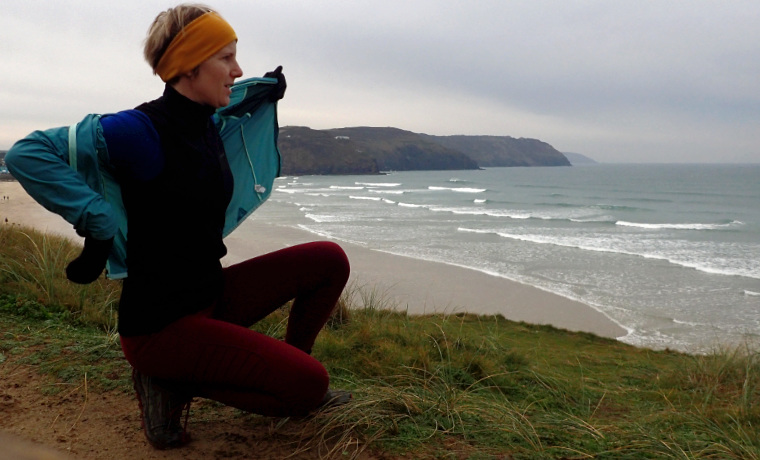
Another good way to avoid overdressing is to…
04Imagine the temperature is higher than it is
Check the outside temperature before you put on your running clothes and then dress as if it’s 15-20º F (8-11ºC) warmer than the actual temperature. I recommend doing this BEFORE you set foot outside to test the temperature. As soon as you experience how cold it “feels” it’s most likely you’ll immediately want to put more layers on that you probably don’t need.
05Allow for wind chill
Before you head out in your skimpy onion layers hoping that your body temperature will adjust to the balmy conditions that you’ve manufactured in your head, it’s worth checking the “feels like” temperature on your weather report. In calm conditions this is likely to be very similar to the actual temperature. In which case, crack on with the above layering tactics! However, if it’s windy the chill factor can take off a good few degrees from the actual temperature. And this shouldn’t be ignored. Use this “feels like” temperature as the true temperature and then adjust from there as you see fit.
06Consider how you are running
Yes, with one foot in front of the other! But how fast, where and how far are you intending to run. A long run at your natural pace will require you to wear warmer running clothing than if you’re doing a shorter tempo run. Likewise, if you’re running on flat terrain your temperature will be relatively stable compared to running on hilly terrain where it will fluctuate much more. In this case, you’ll need to consider your layering options a bit more carefully.
07Try different things
All of the above tips are merely pointers to work from as every runners’ body reacts differently to running in the cold. As such, the best way to figure out how to dress for winter running is to do a little bit of experimenting. I’m not suggesting heading out in your shortest shorts and tiniest tank top and seeing what happens! But play around with which layers work together and in which conditions.
Over time, most runners tend to intuitively know what they need to wear to suit their own bodies. And it’s not uncommon to see two side-by-side runners wearing totally different types of running clothing! But if you’re new to winter running then take the advice in this article and then adjust from there as you get to know your body.
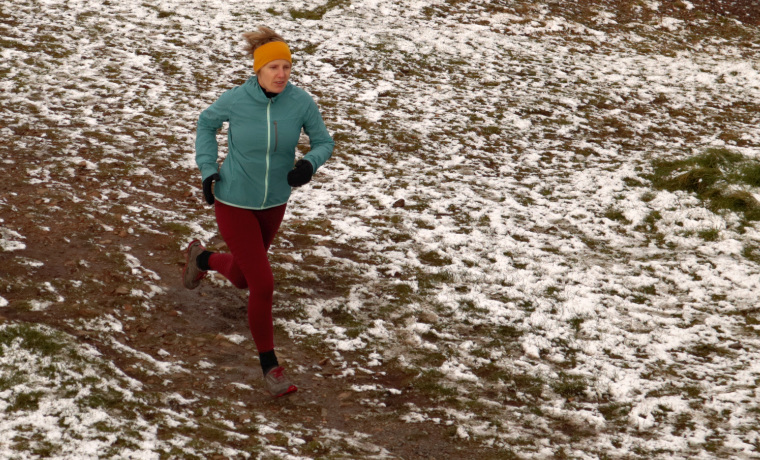
What to wear running in the cold
As mentioned, choosing what to wear running in the cold is an evolving process that you’ll adjust with time and experience. However, as a starting point to work from, read on to see what I tend to run in when it’s cold outside. Bear in mind that I’m a relatively cold person and tend to generally err on the side of being a bit chilly in almost all weather!
What to wear running in 50 degree weather
Though it’s the mildest “winter” temperature, I actually find this temperature (50ºF / 10ºC) the most difficult to dress for when running in winter. And I find it difficult not to overdress. It still “feels” cold out, but is actually much warmer than you might initially realise.
So long as it’s dry and not too windy I try to override my desire for warmer clothing and instead usually wear a loose-fitting merino t-shirt, like the Smartwool Tee below, with a lightweight windbreaker over the top. On my bottom half I wear either a pair of shorts or below the knee leggings, depending on how I’m feeling!
If the sun’s out then I might even take off the windbreaker and either tie it round my waist or pack it into its own pocket and carry it.
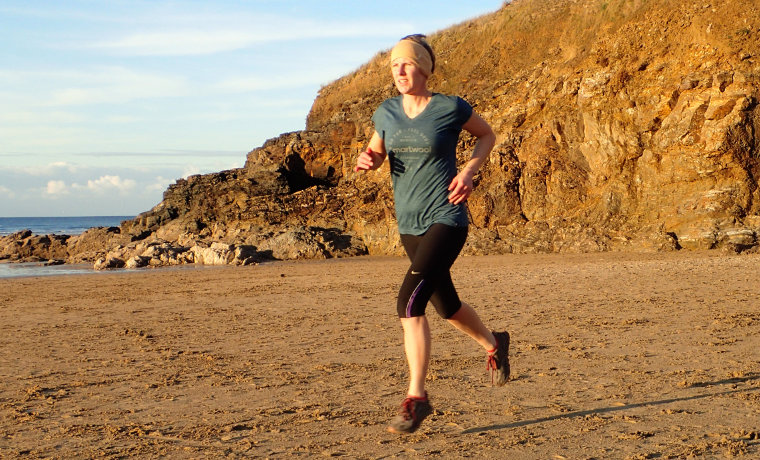
Image: Smartwool Merino Sport 150 Go Far Feel Good Tee
What to wear running in 40 degree weather
What you wear running at around 40ºF / 4ºC creates a base to work from in colder conditions. Anything below 45ºF / 7ºC, I tend to wear the same things and then add more layers as the temperature decreases and / or as the other weather conditions worsen.
Around this temperature is my preferred temperature for winter running. It’s less easy to overdress and I find the cold keeps me pacing well to help me keep warm!
Running layers for my top half
At this temperature, a good base layer is essential. Some people prefer running in synthetic, but I find merino hard to beat and opt for something that is mid weight, like the Smartwool Intraknit 200 Crew featured below.
I love that I don’t need to wash my merino layers after each wear and I find that they help to regulate my temperature much more effectively than synthetic layers. The main downside to merino clothing, however, is that it doesn’t dry as quickly as synthetic fabrics, which can be an issue if you’ve overheated and over-sweated.
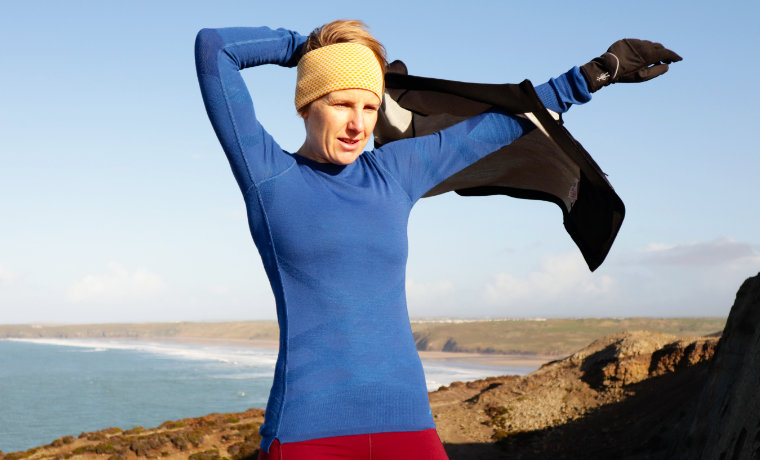
Image: Smartwool Intraknit 200 Crew
Over the top of my base layer I wear a lightweight windbreaker which I sometimes tie around my waist, especially if the sun’s out. If the wind chill is dragging the temperature down then I might wear a loose t-shirt between these layers.
Running layers for my lower half
On my lower half I wear a good pair of warm, full-length leggings. Some people wear below the knee tights or even shorts and long socks. However, I prefer the warmth of full leggings.
The Smartwool Merino Sport Moto Tight, pictured below, are super warm and very soft on the inside. They have a high waist that is snug but not too tight, and the high elastane content ensures they stay well in place. The temperature certainly needs to be dropping below 45ºF / 7ºC for them to be feasible for longer distance runs. Anything above that temperature and they’re too warm for running, but are ideal for hiking or even everyday wear with a long and chunky wooly sweater!
Whatever you opt for as your lower half running attire, a comfortable and fitted waistband is essential. High or low waist comes down to personal preference. But the fit should be good enough that they don’t sag down or ride up at the crotch as you run.
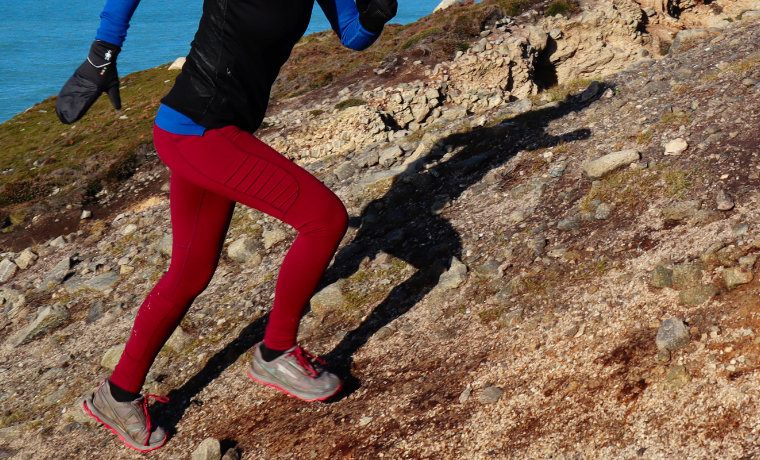
Image: Smartwool Merino Sport Moto Tight
NOTE: Despite these being labelled as “Merino”, it’s only the trim that contains merino. The main body of the tights are made of polyester, nylon and elastane.
Gloves for running
Gloves are a really tricky thing for many runners. Some folk don’t go near them as their hands become warm as soon as they get going, whilst others never go out without a pair.
I’m in the latter group. However, I do find that if I’m wearing gloves that are too warm for the conditions, my hands sweat to start with and then get really cold as the sweat cools. From this point I really struggle to warm them up.
This is where having a good pocket in your leggings or top layer is super handy. I aim to take my gloves off just before they get too warm and before sweat starts to build. Then put them back on again as they cool. The lack of moisture in the process means that they warm up much more quickly.
Running gloves should be moisture wicking and not too thick. But they should also protect from the elements. This is where breathability can become an issue. So I love Smartwool’s Sport Fleece Wind Mitten that has an extra layer of protection and warmth for your fingers without compromising on the breathability of the main glove fabric. They also allow you to do things like tie your laces and adjust your watch without exposing your hands to the elements; just flip your fingers out of the mitten pouches!
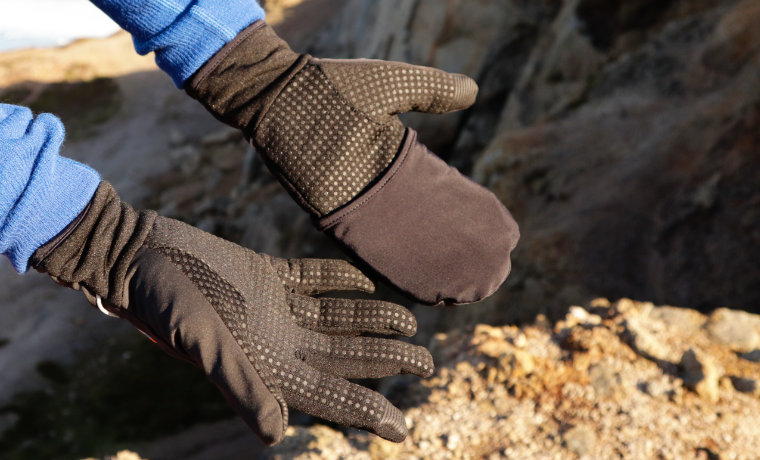
Image: Smartwool Sport Fleece Wind Mitten
Running headwear
Again, what you do or don’t wear on your head when running in the winter largely comes down to personal preference. I’ve always been a headband person. I have sensitive ears and I find that the close fit of a headband protects them more effectively than a beanie hat. I also find I don’t overheat in the same way than I do when wearing a beanie hat. Plus, I like that I can wear a headband around my neck or wrist if I feel the need to take it off.
The yellow headband below (Smartwool Thermal Merino Pattern Reversible Headband) is reversible (dotty on the other side) and also made of 100% merino wool.

Image: Smartwool Thermal Merino Pattern Reversible Headband
What to wear running in 30 degree weather
When the temperature drops below freezing, running can start to get tough. So getting your layering right is essential.
All of the above clothing makes a great foundation to build from. But when running at around 30ºF / -1ºC, you’ll need to add some layers or even swap out a few things.
The first thing to consider is your core temperature. There are a couple of options here, depending on your preference. You can opt for a thin mid layer like a fleece, choose a lightly insulated jacket with windproofing properties or go for a lightly insulated vest. In really cold conditions, you might need the extra warmth of long sleeves. But in the spirit of dressing like an onion, I really like running in a vest, which I wear directly over my base layer, and then having a lightweight wind jacket over the top.
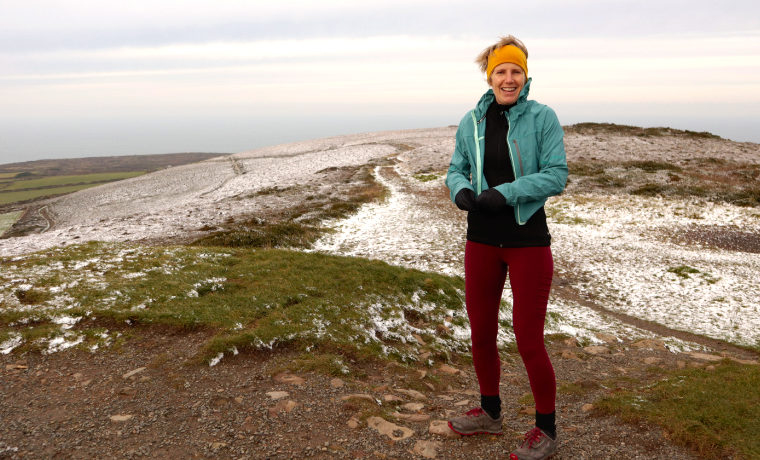
This is how I usually start my run. And then, depending on the terrain and/or the wind, it gives me then option to shed my outer layer and just run in my base layer and vest.
The below Smartwool Intraknit Merino Sport Vest provides the perfect balance of wind protection, warmth and breathability. The front panel is soley made of polyester and facts like a soft shell jacket, keeping out the breeze whilst retaining good breathability. Conversely, the back panel is a blend of merino, polyester and elastane to create a thin, breathable, temperature regulating and close fit knit-like fabric that hugs the body and moves with it.
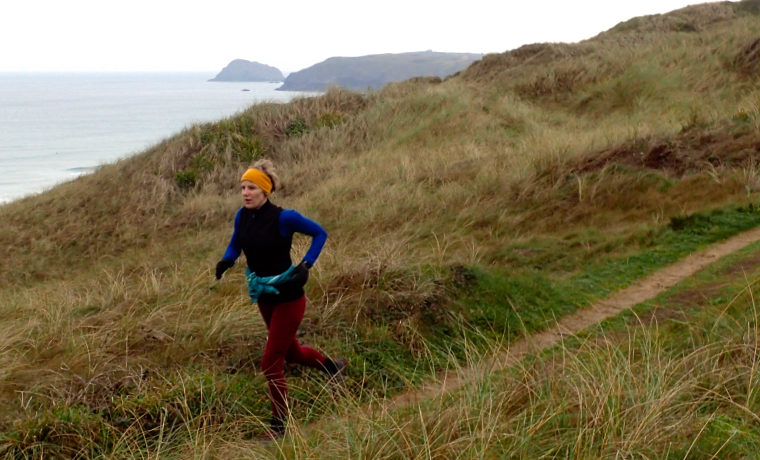
Image: Smartwool Intraknit Merino Sport Vest
Another thing to consider when running in temperatures as low as this is whether you upgrade your leggings to something warmer. I find that the Smartwool Merino Sport Moto Tights (pictured) are warm enough at around 25ºF / -4ºC. However, running in temperatures below that isn’t something that is done frequently in the UK – at least not in the south where I live! So, I can’t comment on how well these perform in colder temperatures.
Running in the cold, wet and wind!
If you’re even reading this section then well done! This means you have, at the very least, some ambition to be out running in winter weather that most people wouldn’t even open their front door to. It also means that you are very aware that clothing for winter running isn’t just about keeping out the cold.
Our hypothetical winter weather scenario looks a bit like this:
Temperature: 34ºF/ 1ºC
Precipitation: Heavy and prolonged periods of rain, verging on sleet
Wind: 25+ mph
It’s grim! And it doesn’t look set to improve. So, at this point, it’s worth asking the question as to whether you really need to go out running in weather like this.
There are many reasons why running in this kind of weather is non-negotiable for some of you. And on most occasions, I’m with you! Running in extreme weather can be super enjoyable for experienced runners. You’re fully exposed to all that the elements have to throw at you and it can be a highly invigorating, humbling and revitalising experience. But only if you are in the right place mentally and are wearing the right clothing.
Going running in extreme weather like this can also be quite a dangerous activity if you’re not well prepared and properly equipped. Run with at least one other person and tell someone at home your proposed route and timings. This is especially important in more rural areas or when heading off road.
What to wear running in the cold, wet and wind
You’ve decided that it’s a good idea to go running in what some might call apocalyptic weather. Good for you! So, what are you going to wear?
The main difference between running clothing for 30ºF / -1ºC temperatures and running clothing for our aforementioned hypothetical weather conditions, are your outer layers.
I add a very good and breathable waterproof jacket to my winter running outfit. This has a good hood and extra length at the back with zippered vents to help with temperature regulation.
I also wear waterproof gloves instead of windproof gloves. And I accept that my bottom half is going to get a pummelling from the elements!
As such, I keep my runs in said apocalyptic conditions short!
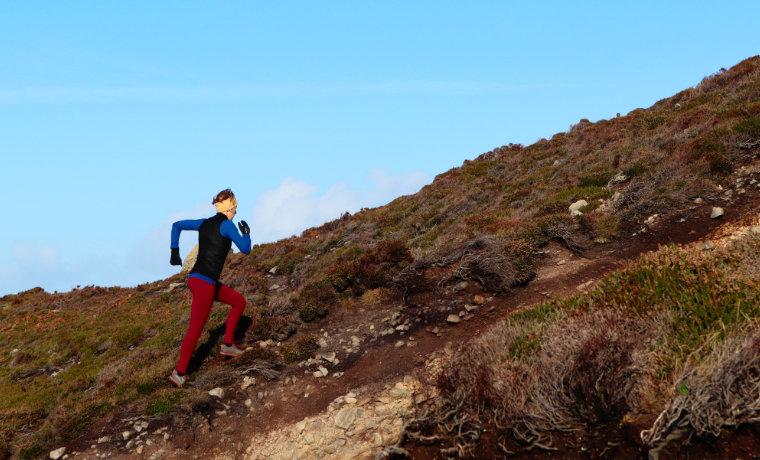
What to look for when choosing winter running clothes
Most summer or warm weather running clothes don’t need to be especially technical. You can get away with any old sports t-shirt and shorts so long as they’re comfortable and aren’t made of cotton.
Unfortunately choosing what to wear running in the winter isn’t quite as simple as that. Winter running clothes are usually made from more technical fabrics that have more design features and are better suited to extreme conditions than clothing you might wear during warmer weather.
The below factors will contribute to the overall comfort of your running clothes, whatever conditions you are running in. So when deciding what to wear running in winter, be sure to check that each item is fit for purpose to be as comfortable as possible.
01The fit of your running clothes
You can get away with ill-fitting clothing in everyday life. But when running, even the smallest misfit can cause a lot of discomfort.
Generally speaking, your winter running clothes should be:
- Fitted but not too tight — they shouldn’t cause any kind of restriction when running.
- Not baggy — excess fabric can cause rubbing and chaffing which should be avoided at all costs.
- The right length — running tights and tops that are too short create drafts and expose skin to the elements. Tuck your tights into your socks and your base layer into your tights.
- The right size — running tights that are too big at the waist or not quite tight enough over your legs can start to fall down and sag as you run. This is really annoying! And can also cause chaffing over time.
Get the fit right and you’re halfway there to a highly comfortable outfit for winter running.
02Fabric properties of your winter running clothes
The fabric of your running clothes is the next most important thing to consider once you’ve got the fit right. This is where things get a little more complex, so stick with me!
Each item of running clothing has a specific job to do, mostly determined by the fabric from which they are made.
Desirable properties of winter running clothes:
- Temperature regulation – keeping you both cool when you’re working extra hard and keeping you warm in the cold.
- Moisture wicking – moving moisture (sweat) away from your skin.
- Quick drying – moving moisture away from your clothing into the atmosphere — quickly!
- Odour control – preventing bacteria from growing on your clothes.
- Breathability – allows air and moisture vapour to move through the fabric.
- Waterproofing – stopping water from getting inside your clothing.
- Windproofing – preventing the wind from penetrating your clothing.
Each of the above jobs, when done properly, contribute to the overall comfort of winter running clothes.
03Types of fabric for winter running clothes
-
Merino wool
Good at: Moisture wicking, odour control, temperature regulation, providing warmth when wet, breathability
Bad at: Drying quickly, rinsing your bank account! -
Synthetic fabrics (polyester, nylon or blends)
Good at: Drying quickly, moisture wicking, not holding water
Bad at: Odour control, providing warmth when wet -
Polyester fleece
Good at: Drying quickly, moisture wicking, not holding water
Bad at: Odour resistance
The post What to Wear Running in the Winter appeared first on Cool of the Wild.


